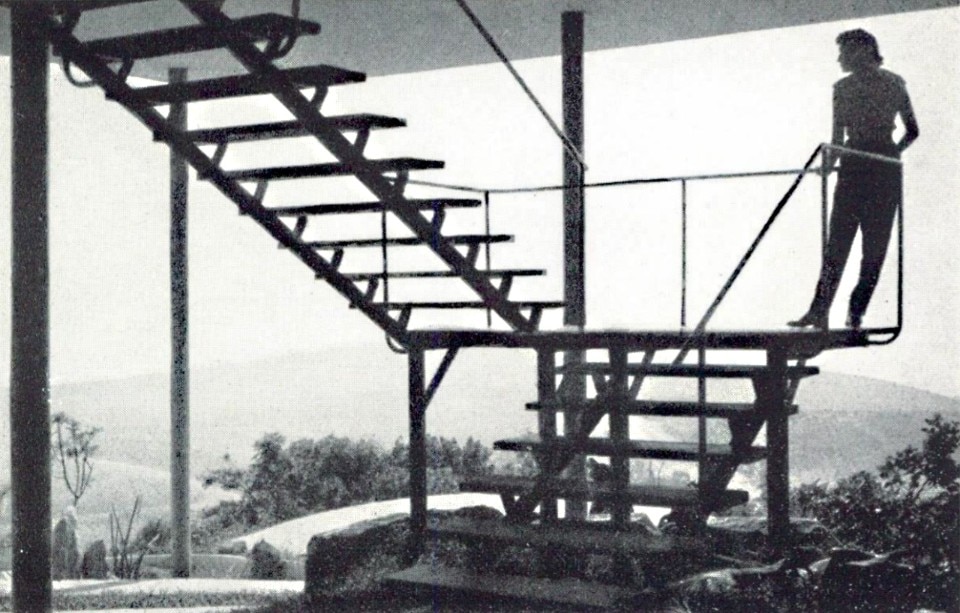After World War II, Lina Bo left Italy and by then had established in Brazil her own thriving practice as a designer that would confirm herself as a leading figure in a crucial season for South American architecture, an independent voice within the scene of Brutalismo Paulista between figures like Paulo Mendes da Rocha and João Batista Vilanova Artigas. Hers was a bridging figure in fact, between different epicenters of global architecture, combining research paths from European modern with the autonomous paths of his new home continent. The 1950s were, in this field, years in which boundaries reopened, models and languages circulated making that international style existed mainly in theories during previous decades, a matter of reality. Domus immediately recounted and supported this exchange, publishing the architectures for peace of a young Kenzo Tange in 1952, and, on 279 issue of February 1953, it presented through the words of Gio Ponti the Casa de vidro, the manifesto of another modernity, signed by Lina Bo Bardi.
.png.foto.rmedium.png)
“Casa de vidro”, Lina Bo Bardi arch.
In the architecture of this house that we’ll call “casa de vidro", as they already call it in São Paulo, one can be pleased to find a correspondence with those principles modern architecture is moving towards, in the work of its most intelligent representatives.
Essentiality: the house, lying entirely on one level, partly protrudes hovering on the sloped land below. It is crystal clear. Horizontal volume and very thin vertical uprights touch and cross each other, all while remaining independent; there is no confusion: the horizontal volumes of walls and glass of the house, are indeed better expressed by the slenderness of the uprights, due to the deliberate absence of a visible structural texture that would have made the composition “descend” to the ground. For this purpose, all elements located in the void “underneath” the walls of the house (and not what is embedded in the ground), is exclusively made of metal (uprights and stairs).
.png.foto.rmedium.png)
The “floating” part (which is not cantilevered, but supported) is entirely glazed, transparent, light: it is exact. This is a most intelligent architecture, with nothing more or less than what is necessary. Nothing to add, nothing to take away. Essential.
È un esemplare unico, nuovo, isolato, non imitabile, e tuttavia pieno di insegnamenti. […] Questo risultato totale di finito, di risolto, senza lacune, è una lezione d’architettura, che convalida un’opera che noi ammiriamo.
.png.foto.rmedium.png)
Illusiveness: all architectures have equal natural weight, but unequal expressive weight. This house has zero “expressive weight”, which means that it creates an illusion of extreme lightness. In the end, the two horizontal slabs are values of illusiveness, two lips with thin ends, floating: they turn out as exciting as all expressions of art. Everything in between is crystals. Space, emptiness, is not subdivided by walls: it flows instead through the totalizing glazing, penetrates and traverses the house even from beneath the small glazed patio. It is space and not volume: if anything, a transparent volume. It is a house immersed in the air, it is periscopic.
Here lie some of its poetic values. The place where to spend the day is hovering in the void, it is the eye of the house, it is all light, air, sun, greenery, space, atmosphere: it is a balcony, a place for observation. The place dedicated to the night is instead, as it must be, walled, secret: a protector of hibernation; and the same applies to the service areas, bowels of the house. Perfect. More poetic values, conceived with master’s hand, lie within these walled parts, where one must spend the indoor time: experts will just need to see the photos to understand.
.png.foto.rmedium.png)
Fantasy of precision: the house comes from the utmost fantasy, a difficult fantasy, that of precision, rigor, coherence, unity. Architecture, I said, is a crystal. Let us once and for all remove from “fantasy” the meaning of fickleness, of frills, of romantic abandon, of something melodic: let us return to its meaning of a totally fantastic conception, in a Bachian rigor. So is this house: it is not “full of fantasy”, it is an act of fantasy: it is also a fantasy in its bravery, which is perhaps temerity.
Personality: rigor, total consistency even in minute details are the sign of the strength of a personality. Sometimes personality is sought or reduced in condescensions, indulgences, abandonments; here, it is recognized instead in virtues (virtus-strength), which are unity, rigor, consistency, skill of craft, singularity, no abandonments, no concessions: this house wants to be unique, rejecting any commonplace or common solution (there are no brise-soleil). It is unique, new, isolated, unimitable, and yet full of lessons. Those who have seen and admired it, as I have, remember many most interesting solutions; from the electrical connections integrated in the walls, to the water drains. This total result so finished, resolved, flawless, is a lesson in architecture, validating a work that we admire.
.png.foto.rmedium.png)
Lina Bo, a very intelligent woman who worked in Milan, left us without news of her work in Brazil. We like to be the first to show some beautiful evidence of such work, in Italy. It earns a place for itself in modern architecture. And the “Casa de vidro” must be classified in the category of modern architecture. It does honor Brazil that generated its motivations, and Italy, where the school it derives from are located.


